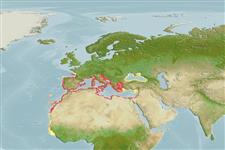>
Blenniiformes (Blennies) >
Blenniidae (Combtooth blennies) > Salariinae
Etymology: Parablennius: Greek, para = the side of + Greek, blennios = mucus (Ref. 45335).
Environment: milieu / climate zone / depth range / distribution range
Ökologie
seewasser; brackwasser demersal; tiefenbereich 3 - 15 m (Ref. 5981). Subtropical; 47°N - 9°N, 19°W - 42°E
Eastern Atlantic: coast of Portugal, Spain and Morocco south to Guinea. Also in all parts of the Mediterranean (except Syria, Lebanon, Israel and Egypt), in the Sea of Marmara and the Black Sea, and Canary Islands (Ref. 5981).
Size / Gewicht / Alter
Maturity: Lm ? range ? - ? cm
Max length : 15.0 cm TL Männchen/unbestimmt; (Ref. 3397)
Facultative air-breathing in the genus (Ref. 126274); Adults occur over sandy bottoms with boulders and light vegetation. They hide in crevices where the nests are being guarded by the male (Ref. 5981). Oviparous. Eggs are demersal and adhesive (Ref. 205), and are attached to the substrate via a filamentous, adhesive pad or pedestal (Ref. 94114). Larvae are planktonic, often found in shallow, coastal waters (Ref. 94114).
Life cycle and mating behavior
Geschlechtsreife | Fortpflanzung | Ablaichen | Eier | Fecundity | Larven
Oviparous (Ref. 205). Several females visit the hole to spawn with the resident male which guards the nest (Ref. 5981).
Bath, H., 1990. Blenniidae. p. 905-915. In J.C. Quero, J.C. Hureau, C. Karrer, A. Post and L. Saldanha (eds.) Check-list of the fishes of the eastern tropical Atlantic (CLOFETA). JNICT, Lisbon; SEI, Paris; and UNESCO, Paris. Vol. 2. (Ref. 5298)
IUCN Rote Liste Status (Ref. 130435: Version 2024-2)
Bedrohung für Menschen
Harmless
Nutzung durch Menschen
Fischereien: nicht kommerziell; Aquarium: Kommerziell
Tools
Zusatzinformationen
Download XML
Internet Quellen
Estimates based on models
Preferred temperature (Ref.
123201): 16.1 - 21.7, mean 19.2 °C (based on 643 cells).
Phylogenetic diversity index (Ref.
82804): PD
50 = 0.5000 [Uniqueness, from 0.5 = low to 2.0 = high].
Bayesian length-weight: a=0.00851 (0.00489 - 0.01483), b=2.90 (2.75 - 3.05), in cm total length, based on LWR estimates for this species & Genus-body shape (Ref.
93245).
Trophic level (Ref.
69278): 3.3 ±0.3 se; based on diet studies.
Widerstandsfähigkeit (Ref.
120179): hoch, Verdopplung der Population dauert weniger als 15 Monate. (Preliminary K or Fecundity.).
Fishing Vulnerability (Ref.
59153): Low vulnerability (10 of 100).
Nutrients (Ref.
124155): Calcium = 115 [19, 351] mg/100g; Iron = 1.38 [0.53, 4.36] mg/100g; Protein = 4.03 [0.31, 7.75] %; Omega3 = 0.443 [0.188, 1.034] g/100g; Selenium = 9.83 [2.13, 28.31] μg/100g; VitaminA = 21.6 [8.6, 54.4] μg/100g; Zinc = 1.25 [0.60, 2.47] mg/100g (wet weight);
